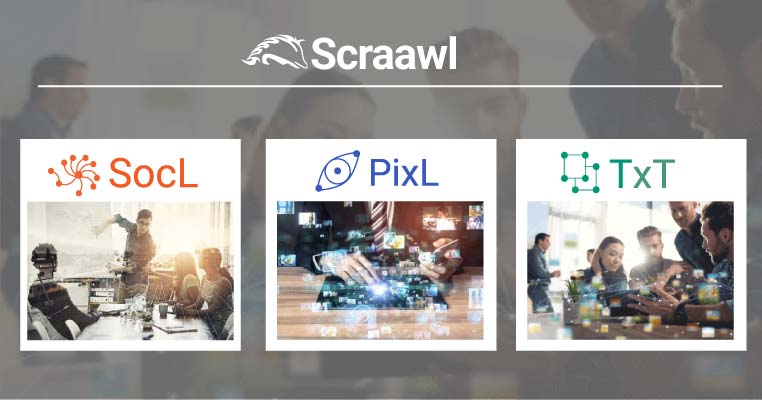Spring is a time of new beginnings — and new products from Scraawl. We’re proud to announce the introduction of Scraawl as an analytics suite and the addition of two new products: Scraawl PixL and Scraawl TxT. To complete the transition, Scraawl will hitherto be called Scraawl SocL.
Each of the tools within the product suite leverage advanced machine learning techniques for data analysis. Scraawl SocL will continue to offer social media and text data analytics. Scraawl PixL will be able to process both images and video for data analysis and Scraawl TxT will focus on large text corpuses from a variety of sources, such as PDFs, Word documents, and emails.
Scraawl remains dedicated to providing exceptional technology solutions at competitive pricing. To learn more about each new product, feel free to explore the updated website, or read on below.
Scraawl SocL
Scraawl SocL (pronounced as Social) was the first tool developed within the product suite and in many ways, stands as the flagship of the brand. Scraawl’s development team has diligently worked on the tool for the past four years and has scaled the product to accomodate its growing number of users.
Scraawl SocL offers analytics on a variety of platforms, including: Twitter, Facebook, Instagram (coming soon), tumblr, YouTube, and news feeds. These Advanced Analytics include but are not limited to Influence Discovery, Topic Modeling, Sentiment Analysis, and the recently updated Bot Detection analytic.
On the blog, we’ve written numerous articles on how to best leverage Scraawl SocL for each of these platforms and how to integrate these analytics into workflows. Outside of the blog, we offer other resources such as training and analytic services. We also have a on-premise install solution for those who wish to keep all data collection and analysis in-house.
With the changing landscape of data analytics and digital environments, it was imperative to prepare for new types of big data such as videos and images. As the demand for Scraawl SocL grew, so too did the need for a data analytics for multi-media data processing.
Scraawl PixL
Thus began the development of Scraawl PixL. PixL employs computer vision to provide object detection, face detection, and facial recognition on visual data from videos and images. Some of the potential use cases for Scraawl PixL include security, brand monitoring, and UAV (drone) footage analysis. In fact, PixL can be used for analysis of video and images from robotics, drones, security cameras, event footage, and more.
The Scraawl team also developed an embedded video player within PixL so users can manipulate the view on uploaded videos. Users can zoom, pan, change the hue or saturation, and view the videos with applied PixL analytics.

PixL’s Advanced Analytics include the following:
Face and Object Detection
Face and object detection analytics are based on state-of-the-art convolutional neural networks and deep residual learning. As a result, Scraawl PixL can detect and recognize faces in unconstrained conditions. For example, PixL can detect faces standing in profile and not facing the camera.
For each detected face, PixL uses a deep neural network to cluster similar faces. And, once the face or object detection analytic has been run, the detected faces can be viewed within the video player.
With object detection, PixL can recognize hundreds of different types of objects from types of vehicles to everyday household goods.
Satellite Analytics
In addition to detecting objects and faces, PixL also offers Satellite Analytics. As a problem set, it can be difficult for machines to differentiate objects from a bird’s eye view.

To address issues related to low resolution data and the overhead camera angle, PixL Satellite Object Detection Analytics leverage specially trained machine learning models to identify objects of interest in satellite imagery.
PixL’s algorithm was trained using a satellite image dataset containing millions of labelled objects. Thanks to its robust training data set, the model can predict the positions of bounding boxes, the object classes, and their probabilities with high accuracy. PixL will be released soon, in the winger of 2018 into 2019. If you are interest in learning more about PixL, get in touch through our Contact Page.
But it was not enough to develop one more new product. Thanks to feedback from our users and market demands, the Scraawl team also saw a need for a large-scale text analytics tool.
Scraawl TxT
Enter Scraawl TxT. This last tool in the arsenal focuses on large text data. TxT uses Natural Language Processing to provide context-aware information extraction from large-scale text documents Once information has been extracted, TxT users can then search content and apply analytics.

TxT will provide text analysis for a variety of data sources, including news articles, reports, blogs, documents, comments, chat transcripts, SMS, and e-mail. The plethora of data types will help improve the searching and filtering of large data collections to aid in fraud detection, customer support, and knowledge discovery.
With TxT users can perform multidimensional search for key actors, discover topics, events, and relationships of interest, topic clusters, and compare analysis results based on context variables such as time, authorships, sentiment, and source.

Analytics within Scraawl TxT include:
Entity Analytics
Named entity recognition and resolution helps users detect organizations, people, and locations with the data set. TxT can even determine when two entities refer to the same thing in the real world (entity resolution).
Scraawl TxT also offers entity relation network graphs, which plot the conections between extracted entities within and across documents.
Content Analytics
Like the content analytics available in SocL, Scraawl TxT will also offer Topic Modeling and a Timeline. TxT will be able to analyze repository of documents to find larger themes. Similar to SocL’s algorithm, TxT’s topic modeling analytic uses a language-independent probabilistic model to partition conversations into distinct topical threads.
TxT’s Timeline analytic will offer a break-out view of articles to gain a better temporal view of events and trends.
Image Processing Analytics
A common thread amongst all three products, SocL, PixL, and TxT will be the inclusion of image processing analytics. For TxT, this will include a Media Gallery and the option to export images to PixL for further analysis.
TxT will be released further down the line, sometime in 2019. If you are interested in learning more about TxT, get in touch through our Contact Page.
Looking forward to 2019
Integration across the tools will be a major component of future releases. Often, big data analysis does not have the luxury of working with just one data type. The Scraawl analytics suite aims to address the reality of multi-type data analysis by equipping analysts with the cutting-edge resources necessary to compete in today’s digital space.
At Scraawl, we are excited but the upcoming upgrades and the new products. We invite you to get in touch if you have any questions. Stay tuned.






